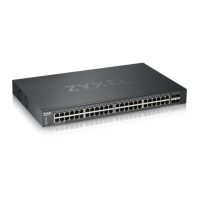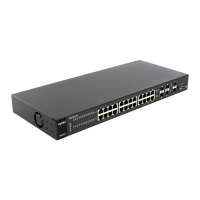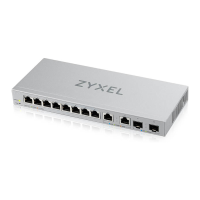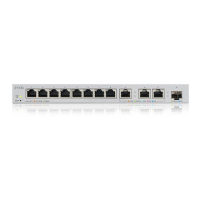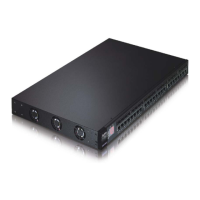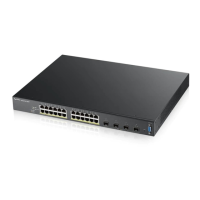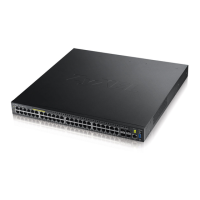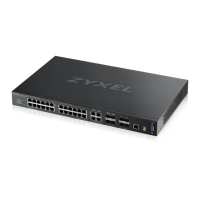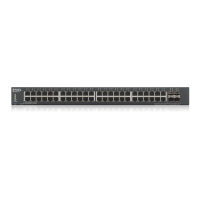
Do you have a question about the ZyXEL Communications XGS1930-28 and is the answer not in the manual?
| Brand | ZyXEL Communications |
|---|---|
| Model | XGS1930-28 |
| Category | Switch |
| Language | English |
Introduces the main features and applications of the Switch.
Shows how to install and connect the Switch, including desktop and rack mounting.
Details the front panel layout and specifications of the Switch.
Introduces the HTML-based management interface for system setup and management.
Shows how to set up the Switch for an example network, including VLAN and IP configuration.
Provides examples of using the Web Configurator for setup and basic operations.
Displays general device information, system status, and IP addresses.
Covers configuration of System Info, General Setup, Switch Setup, IP Setup, Port Setup, etc.
Introduces configuring 802.1Q tagged and port-based VLANs.
Discusses configuring forwarding rules based on MAC addresses of network devices.
Discusses configuring forwarding rules based on multicast MAC addresses.
Discusses MAC address port filtering based on source/destination MAC addresses and VLAN ID.
Introduces STP, RSTP, and MSTP standards and their functionalities.
Defines bandwidth control as setting maximum allowable bandwidth for traffic flows on a port.
Introduces broadcast storm control to limit broadcast, multicast, and DLF packets per second.
Discusses port mirroring setup screens for traffic analysis.
Explains how to logically aggregate physical ports to form one logical, higher-bandwidth link.
Describes methods for validating client access to ports using external servers (802.1x, MAC, Guest VLAN).
Explains how port security allows only packets with learned/configured MAC addresses to pass.
Explains setting up one-time and recurring schedules for time-oriented features.
Introduces packet classifiers for grouping traffic into data flows for QoS.
Explains how policy rules ensure traffic flows receive requested network treatment.
Introduces queuing methods to help solve performance degradation during network congestion.
Shows how to configure various multicast features.
Describes configuring authentication, authorization, and accounting settings using AAA servers.
Explains how DHCP snooping builds binding tables to filter unauthorized DHCP packets.
Explains how Loop Guard guards against loops on the network edge by shutting down ports.
Introduces L2PT for tunneling Layer 2 protocols like STP, CDP, and VTP across networks.
Common ISP protocol, describes PPPoE Intermediate Agent overview.
Explains configuring rate limits for control packets and actions taken upon error detection.
Explains how Green Ethernet reduces switch port power consumption via EEE, Auto Power Down, and Short Reach.
Describes LLDP as a Layer 2 protocol for advertising device identity and capabilities locally.
Introduces static routes for IP communication with unreachable stations or servers.
Explains how DHCP allows individual computers to obtain TCP/IP configuration from a server.
Introduces ARP for mapping IP addresses to MAC addresses.
Explains how to maintain firmware and configuration files for the Switch.
Describes methods to control access to the Switch via FTP, Telnet, SSH, Web, and SNMP.
Explains the Diagnostic screen for identifying network problems.
Explains that log messages store information for viewing system events.
Explains the syslog protocol for sending event notification messages to syslog servers.
Introduces managing multiple switches through a single cluster manager.
Introduces the MAC Table screen showing frame forwarding and filtering across ports.
Introduces the IP Table screen showing how packets are forwarded or filtered.
Introduces the ARP Table for mapping IP addresses to MAC addresses.
Contains route information to networks the Switch can reach.
Introduces the IPv6 Path MTU table for discovering minimum MTU sizes in a path.
Shows how to copy settings from one port to other ports.
Introduces the IPv6 neighbor table for storing link-layer addresses of neighbors.
Introduces the port status screens for viewing port statistics.
Introduces the HTML-based management interface for system setup and management.
Shows how to set up the Switch for an example network, including VLAN and IP configuration.
Provides examples of using the Web Configurator for setup and basic operations.
Displays general device information, system status, and IP addresses.
Covers configuration of System Info, General Setup, Switch Setup, IP Setup, Port Setup, etc.
Introduces configuring 802.1Q tagged and port-based VLANs.
Discusses configuring forwarding rules based on MAC addresses of network devices.
Discusses configuring forwarding rules based on multicast MAC addresses.
Discusses MAC address port filtering based on source/destination MAC addresses and VLAN ID.
Introduces STP, RSTP, and MSTP standards and their functionalities.
Defines bandwidth control as setting maximum allowable bandwidth for traffic flows on a port.
Introduces broadcast storm control to limit broadcast, multicast, and DLF packets per second.
Discusses port mirroring setup screens for traffic analysis.
Explains how to logically aggregate physical ports to form one logical, higher-bandwidth link.
Describes methods for validating client access to ports using external servers (802.1x, MAC, Guest VLAN).
Explains how port security allows only packets with learned/configured MAC addresses to pass.
Explains setting up one-time and recurring schedules for time-oriented features.
Introduces packet classifiers for grouping traffic into data flows for QoS.
Explains how policy rules ensure traffic flows receive requested network treatment.
Introduces queuing methods to help solve performance degradation during network congestion.
Shows how to configure various multicast features.
Describes configuring authentication, authorization, and accounting settings using AAA servers.
Explains how DHCP snooping builds binding tables to filter unauthorized DHCP packets.
Explains how Loop Guard guards against loops on the network edge by shutting down ports.
Introduces L2PT for tunneling Layer 2 protocols like STP, CDP, and VTP across networks.
Common ISP protocol, describes PPPoE Intermediate Agent overview.
Explains configuring rate limits for control packets and actions taken upon error detection.
Explains how Green Ethernet reduces switch port power consumption via EEE, Auto Power Down, and Short Reach.
Describes LLDP as a Layer 2 protocol for advertising device identity and capabilities locally.
Introduces static routes for IP communication with unreachable stations or servers.
Explains how DHCP allows individual computers to obtain TCP/IP configuration from a server.
Introduces ARP for mapping IP addresses to MAC addresses.
Explains how to maintain firmware and configuration files for the Switch.
Describes methods to control access to the Switch via FTP, Telnet, SSH, Web, and SNMP.
Explains the Diagnostic screen for identifying network problems.
Explains that log messages store information for viewing system events.
Explains the syslog protocol for sending event notification messages to syslog servers.
Introduces managing multiple switches through a single cluster manager.
Introduces the MAC Table screen showing frame forwarding and filtering across ports.
Introduces the IP Table screen showing how packets are forwarded or filtered.
Introduces the ARP Table for mapping IP addresses to MAC addresses.
Contains route information to networks the Switch can reach.
Introduces the IPv6 Path MTU table for discovering minimum MTU sizes in a path.
Shows how to copy settings from one port to other ports.
Introduces the IPv6 neighbor table for storing link-layer addresses of neighbors.
Introduces the port status screens for viewing port statistics.
Addresses common issues related to power, hardware, access, login, and configuration.
Lists required information and contact details for Zyxel customer support.
Lists commonly used services, their protocols, port numbers, and descriptions.
Explains IPv6 addressing, subnet masking, interface IDs, and associated protocols.
Provides copyright, disclaimer, regulatory notices, and safety warnings.
